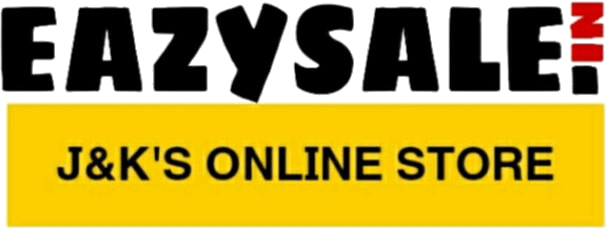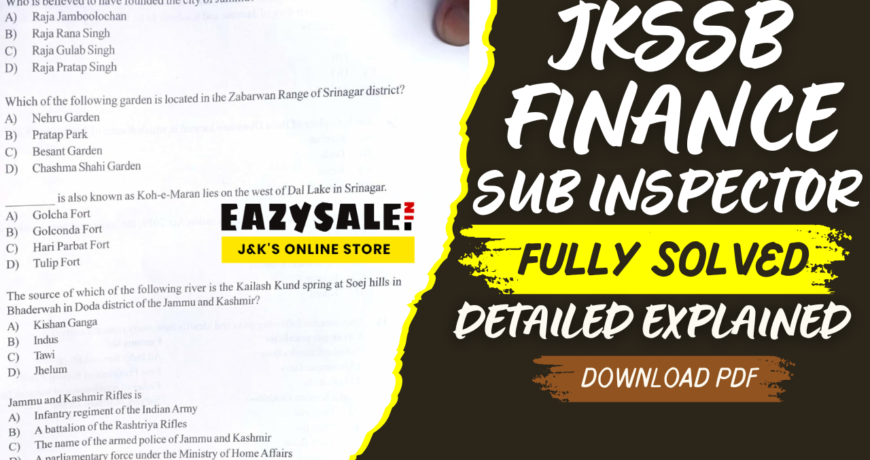No products in the cart.
JKSSB Finance Sub Inspector Solved Paper PDF 2024 Leave a comment
JKSSB Finance Sub Inspector Solved Paper PDF 2024
This article contains a series of multiple-choice questions related to the JKSSB Finance Sub-Inspector Question Paper 2024 under which the different subjects like English, J&K GK, General Studies, geography and history of Jammu and Kashmir. The questions cover various topics such as the founding of Jammu, famous gardens in Srinagar, forts in the region, and the source of rivers in Jammu and Kashmir. Additionally, the document includes information about the Jammu and Kashmir Rifles, the Tawi River, and the establishment of the Union Territory of Jammu and Kashmir. Readers can test their knowledge on the geographical and historical aspects of the region through these questions.
Key Concepts
- The content covers topics related to the geography and history of Jammu and Kashmir.
- It includes information on famous gardens, forts, and rivers in the region.
- The document mentions military forces, historical boundaries, and popular tourist destinations in Kashmir.
- It also provides details on the J&K Reorganization Act, personalities, and important landmarks in the region.
- The content touches on various subjects like technology, computer science, and open-source software.
- It discusses semiconductor memories, open-source software, and database-related fields.
- The content also includes information on MS Excel, PowerPoint shortcuts, and page margins.
- Recent topics like Hygroelectricity, the Blue Economy 2.0, and the 2023 Ramon Magsaysay award are also covered in the content.
| JKSSB Finance SI Question Paper PDF | Download Now |
| JKSSB Finance SI Answer Key PDF | Download Now |
| JKSSB Finance SI Solved Paper PDF | Download Now |
| Get 11000+ Most Expected MCQs | Shop Now |
Summary of JKSSB Finance SI Question Paper:-
The set of 120 questions provided covers a wide spectrum of topics, ranging from the geography and history of Jammu and Kashmir to significant personalities in Indian history. It touches upon legislative reforms, aviation pioneers, and the evolution of computing technology. Additionally, questions delve into health-related matters, financial markets, and the functioning of international organizations. This comprehensive array of inquiries not only tests knowledge of specific facts but also challenges understanding of broader concepts and developments in various fields. From landmarks in Jammu and Kashmir to the headquarters of UNESCO, from the first Indian newspaper to the functioning of email protocols, these questions offer a holistic examination of diverse subjects, making it an enriching exercise in general knowledge acquisition.
- Who is believed to have founded the city of Jammu?
- A) Raja Jamboolochan
- B) Raja Rana Singh
- C) Raja Gulab Singh
- D) Raja Pratap Singh
- Explanation: Raja Jamboolochan is believed to have founded the city of Jammu.
- Which of the following garden is located in the Zabarwan Range of Srinagar district?
- A) Nehru Garden
- B) Pratap Park
- C) Besant Garden
- D) Chashma Shahi Garden Explanation: Chashma Shahi Garden is located in the Zabarwan Range of Srinagar district.
- is also known as Koh-e-Maran lies on the west of Dal Lake in Srinagar.
- A) Golcha Fort
- B) Golconda Fort
- C) Hari Parbat Fort
- D) Tulip Fort Explanation: Hari Parbat Fort, also known as Koh-e-Maran, lies on the west of Dal Lake in Srinagar.
- The source of which of the following river is the Kailash Kund spring at Soej hills in Bhaderwah in Doda district of the Jammu and Kashmir?
- A) Kishan Ganga
- B) Indus
- C) Tawi
- D) Jhelum Explanation: The source of the Tawi river is the Kailash Kund spring at Soej hills in Bhaderwah in Doda district of the Jammu and Kashmir.
- Jammu and Kashmir Rifles is
- A) Infantry regiment of the Indian Army
- B) A battalion of the Rashtriya Rifles
- C) The name of the armed police of Jammu and Kashmir
- D) A parliamentary force under the Ministry of Home Affairs Explanation: Jammu and Kashmir Rifles is the infantry regiment of the Indian Army.
- Which of the following countries are divided by the Radcliffe Line?
- A) India and Pakistan
- B) India and China
- C) India and Bangladesh
- D) India and Nepal Explanation: India and Pakistan are divided by the Radcliffe Line.
- What is Gulmarg famously known as?
- A) Mountain Queen
- B) Meadow of Flowers
- C) The Crown of Kashmir
- D) God’s own country Explanation: Gulmarg is famously known as the Meadow of Flowers.
- As per the J&K Reorganization Act, the total number of seats in the Legislative Assembly of the Union Territory of Jammu and Kashmir to be filled by persons chosen by direct election shall be
- A) 111
- B) 110
- C) 107
- D) 115 Explanation: As per the J&K Reorganization Act, the total number of seats in the Legislative Assembly of the Union Territory of Jammu and Kashmir to be filled by persons chosen by direct election shall be 107.
- The holy place of Baba Dhansar is located in which district of Jammu and Kashmir?
- A) Ramban
- B) Doda
- C) Reasi
- D) Shopian Explanation: The holy place of Baba Dhansar is located in the Reasi district of Jammu and Kashmir.
- According to the J&K Reorganization Act 2019, the union territory created without legislature is
- A) Ladakh
- B) Jammu and Kashmir
- C) Jammu
- D) Kargil
- Consider the following pairs and identify how many pairs are correct:
Great personalities Famous for
Subhash Chandra Bose All India forward block
Chittaranjan Das First President of Swaraj Party
M G Ranade Father of renaissance of western India
Gopal Krishna Gokhale Servant of Indian society- A) Only one
- B) Only two
- C) Only three
- D) All four
- Who was the first Indian commercial woman pilot?
- A) Gunjan SaxenaB) Durba BanerjeeC) Avni ChoudharyD) Sarojini Naidu
- Who among the following is popularly known as “The Black Tiger”, an intelligence agent?
- A) Saraswathi Rajamani
- B) Kashmir Singh
- C) Mohanlal Bhaskar
- D) Ravindra Kaushik
- The first newspaper published in India was
- A) The Hindu
- B) The Amrita Bazar Patrika
- C) The Bengal Gazette
- D) The Samachar Darpan
- The headquarters of UNESCO is located in
- A) New York
- B) Paris
- C) Geneva
- D) Rome
- Excessive bleeding during an injury is a deficiency of
- A) Vitamin A
- B) Vitamin B
- C) Vitamin K
- D) Vitamin E
- The word Gambit is related to which of the following sports?
- A) Chess
- B) Table Tennis
- C) Polo
- D) Carom
- Which of the following rivers is known as “Vridha Ganga’?
- A) Godavari
- B) Krishna
- C) Mahanadi
- D) Cauvery
- Market in which currencies buy and sell and their prices settle on is called the
- A) International bond market
- B) International capital market
- C) Foreign exchange market
- D) Eurocurrency market
- Which among the following is the oldest nuclear power station in India?
- A) Tarapur Nuclear Power Plant
- B) Kaiga Atomic Power Station
- C) Narora Atomic Power Station
- D) Kakrapar Atomic Power Station
- The first fully automatic calculating machine was developed by
- A) Charles Babbage
- B) Blaise Pascal
- C) Leibniz
- D) John Von Neumann
- During the second generation, the size of computers was decreased by replacing vacuum tubes with
- A) ICs
- B) Semiconductors
- C) Transistors
- D) Microprocessor
- Which protocol provides an email facility among the hosts?
- A) POP
- B) SMTP
- C) IMAP
- D) MIME
- Which of the following is an example of system software?
- A) User interface
- B) Language translator
- C) Platform
- D) Screen saver
- Which of the following printers uses light beam and electrostatic powder?
- A) Dot matrix printer
- B) Daisy wheel printer
- C) Chain printer
- D) Laser printer

